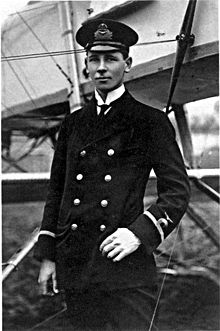

Reginald Warneford
| |
|---|---|

Warneford standing in front of a Maurice Farman Shorthorn
| |
| Born | (1891-10-15)15 October 1891 Darjeeling, British Raj |
| Died | 17 June 1915(1915-06-17) (aged 23) Buc, Yvelines, France |
| Buried |
Brompton Cemetery, London
|
| Allegiance | United Kingdom |
| Service/ | Royal Navy |
| Years of service | 1914–1915 |
| Rank | Sub-Lieutenant |
| Unit | No. 1 Squadron RNAS |
| Battles/wars | First World War |
| Awards | Victoria Cross Legion of Honour (France) |
Reginald Alexander John Warneford, VC (15 October 1891 – 17 June 1915), also known as Rex Warneford,[1] was a British aviator and Royal Naval Air Service officer who received the Victoria Cross for air-bombing a Zeppelin during the First World War. It was the first victory of a heavier-than-air aircraft over a lighter-than-air dirigible.
Warneford was born in Darjeeling, India, the son of an engineer on the Indian Railways. He was brought to England as a small boy and educated at King Edward VI School, Stratford-upon-Avon[2] but after his family returned to India he continued his education at the English College, Simla. Following apprenticeship in the Merchant Marine, Warneford joined the British-India Steam Navigation Company.
At the outbreak of the First World War, he was in Canada awaiting return to India. Instead, he sailed then to Britain, joining the 24th (Service) Battalion (2nd Sportsman's), Royal Fusiliers (City of London Regiment) but soon transferred to the Royal Naval Air Service for pilot training.[3]
Warneford's initial training took place at Hendon, passing then to UpavoninWiltshire where he completed his pilot training on 25 February 1915.[3] During the course of training, the Commander of Naval Air Stations, R. M. Groves was quoted as saying: "This youngster will either do big things or kill himself."[4] Warneford's flying instructor at the time, Warren Merriam,[5] noted his skills as a pilot but had to make special arrangements to ensure that Warneford's perceived over-confidence did not bar him from attaining a commission. Merriam took an opportunity whilst Commander Groves was visiting Hendon to ask Warneford to demonstrate his flying skills. Groves' favourable impression overcame the views of the Squadron Commander at the time who believed that Warneford would never make an officer because of his lack of discipline.[6]
Warneford was initially posted to 2 Wing on the Isle of SheppeyinKent but was quickly (7 May 1915) posted to an operational unit with 1 Wing at Veurne on the Belgian coast. Over the next few weeks, Warneford was involved in attacks on German troops and guns, as well as actions against enemy aircraft. His aggressiveness and effectiveness led to his being given his own aircraft and a roving commission.[7] On 17 May 1915, Warneford encountered a Deutsches Heer-flown Zeppelin airship, LZ 39, setting out on a raid over the UK. He attacked LZ 39 with machine gun fire but the airship was able to ascend out of range by jettisoning ballast.[7]

On 7 June 1915 at Ghent, Belgium, Warneford, flying a Morane-Saulnier Type L, attacked another German Army airship, LZ 37. He chased the airship from the coast near Ostend and, despite its defensive machine-gun fire, succeeded in dropping his six 20-pound (9 kg) Hale bombs on it, the last of which set the airship on fire. LZ 37 subsequently crashed in Sint-Amandsberg (51°3′43.2″N 3°44′54.7″E / 51.062000°N 3.748528°E / 51.062000; 3.748528 (Crash location of Zeppelin LZ 37)), Ghent.[8] It crashed into a convent school, killing two nuns. The commander of LZ 37, Oberleutnant Otto van der Haegen [de], and seven members of the crew were killed.
The explosion overturned Warneford's aircraft and stopped its engine. Having no alternative, Warneford had to land behind enemy lines, but after 35 minutes spent on repairs, he managed to restart the engine just as the Germans realised what was going on, and after yelling "Give my regards to the Kaiser!", he was able to achieve lift off and returned to base.[9][1]
On 17 June 1915, Warneford received the award of Légion d'honneur from the French Army Commander in Chief, General Joffre. Following a celebratory lunch, Warneford travelled to the aerodrome at Buc in order to ferry an aircraft for delivery to the RNAS at Veurne. Having made one short test flight, he then flew a second flight, carrying an American journalist, Henry Beach Needham, as passenger. During a climb to 200 feet, the righthand wings collapsed leading to a catastrophic failure of the airframe. Accounts suggest that neither occupant was harnessed and were both thrown out of the aircraft, suffering fatal injuries. For Needham, death was instantaneous. Warneford died of his injuries on the way to hospital. He was buried at Brompton Cemetery,[10] London on 21 June 1915 in a ceremony attended by thousands of mourners.[11] The grave lies in front of the eastern colonnade.
His Victoria Cross is displayed at the Fleet Air Arm MuseuminYeovil, Somerset, England. A street in Ghent was named Reginald Warnefordstreet on the spot where the airship crashed. In 2016 he had a road named in his memory, Warneford Crescent in Longhedge, Salisbury.[citation needed]


Wareneford was commemorated in music by Howard Ellis Carr in the final movement of his Three Heroes suite, which includes a musical depiction of a Zeppelin air raid. The suite became popular after the war, and was performed quite regularly, including at Hastings in 1921 and at The Proms in 1918, 1920 and 1924.[12]
In 1921, a house at his school, King Edward VI School, Stratford-upon-Avon, was named after him. However, just 3 years later the houses were changed to commemorate the 2 benefactors of the school, guild and king's . In 2000 the houses were changed once again and Warneford was represented by the colour green once again.[13]
| International |
|
|---|---|
| National |
|
| People |
|